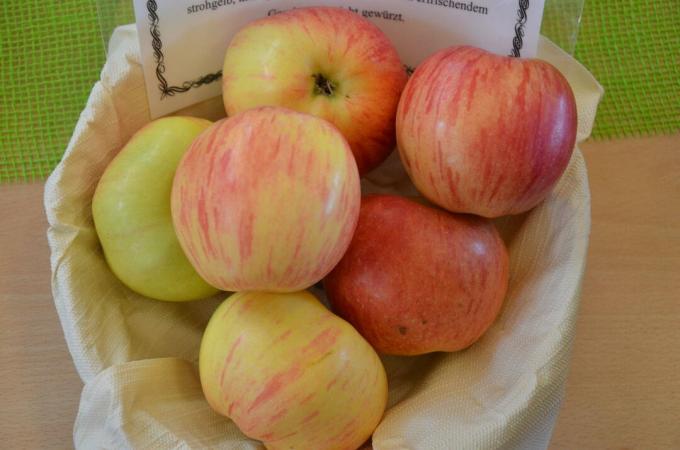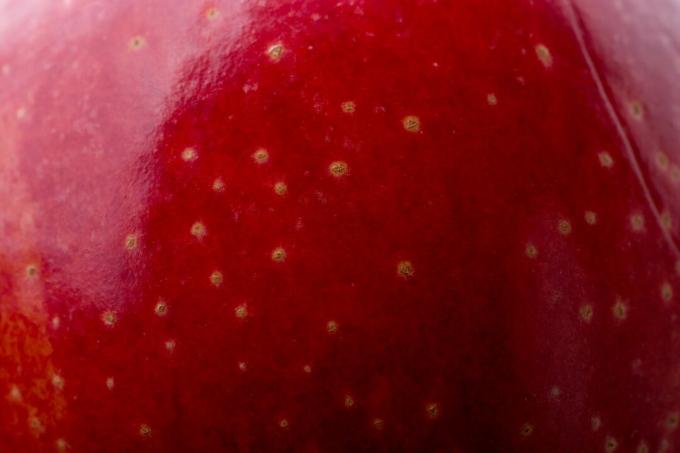How does the Flamed Cardinal apple taste? What are the special features of cultivation? We introduce you to the apple variety with the unusual name.

Hardly any other apple will have as many names as this one: 'Bishop's Hat', 'Rasse Apple', 'Tart Apple', 'Bread Apple', 'Striped Pound Apple', 'Strudel Apple' or 'False Gravensteiner'. It has also been called 'raspberry apple', 'sky rooster', 'hollow cacker', 'rattle apple' or 'hollow house'. In some places it is called 'Kaiserapfel' and in Holstein and Hanover 'Kontoapfel'. It shouldn't be called 'Flamed Red Cardinal' because that name really means a different variety. To distinguish the 'Flamed Cardinal' from this, it is also sometimes called 'Flamed White Cardinal'. We present everything to do with the origin, cultivation and use of the apple.
contents
- ‘Flamed Cardinal’: Wanted Poster
- Origin and history of the 'Flamed Cardinal'
- What does the Flamed Cardinal apple look like and what does it taste like?
- Cultivation & care: special features
- ‘Flamed Cardinal’: Harvest Time & Use
‘Flamed Cardinal’: Wanted Poster
| synonyms | 'Bishop's Hat', 'RasseApple', 'Tart Apple', 'Bread Apple', 'Striped Pound Apple', 'Strudel Apple', 'False Gravensteiner', 'Raspberry Apple', 'Himmelhahn', 'Hollow Cackle', 'Rasse Apple', 'Hollow House', 'Empress Apple', 'Account Apple', 'Flamed White Cardinal' |
| fruit | big; Greenish to yellowish basic color with pale light red stripes when ripe for consumption |
| the taste | weak aroma; juicy, more sour than sweet |
| yield | high; hardly alternating |
| harvest time | from mid-September |
| maturity | from October on |
| shelf life | difficult to store when ripe for consumption; Apples harvested early can be stored until February |
| growth | very strong |
| climate | generally undemanding; not too windy |
| diseases and pests | not susceptible to diseases and pests |
Origin and history of the 'Flamed Cardinal'
The 'Flamed Cardinal' is an apple variety with an unknown history of origin. Its origin is assumed to be in northern Germany and the variety must be very old, as it was already in the year 1801 - including various associated regional designations - was mentioned by a pomologist named Diel. Between 1860 and mid 20th century At the end of the 19th century, the variety is said to have been widespread in Germany, Austria, Hungary, Croatia and the province of Silesia not least because of the multiple recommendations of the variety as a commercial apple by pomologists' associations and government agencies Place. Due to its frugal cultivation characteristics and versatile fruits, it advanced in the mentioned period to a popular kitchen apple, giving rise to the names 'strudel apple' and 'tart apple' developed.
What does the Flamed Cardinal apple look like and what does it taste like?
The 'Flamed White Cardinal' is not only diverse in terms of its name: it is a large and often very irregularly shaped apple. The halves are often unequal and the shape can vary from flat spherical to conical to barrel-shaped. The core is rather large and the cores in it sometimes come loose - this is how the fruit got the name "rattle apple". The surface is rather uneven and angular and the shell is thin and smooth with little wax. The basic color of the 'Flamed Cardinal' is greenish to yellow and is only adorned with pale light red stripes when it is ready for consumption. There are pronounced rusted lenticels all over the shell, which can be seen particularly clearly. Larger rust spots are also possible.
The flesh of the 'Flamed Cardinal' is pithy to crumbly and greenish or yellow-white. The aroma is weak, but the restrained sweetness and the dominating acidity make this juicy apple a real refreshment.
What is striking about the tree is that young shoots and young leaves are very woolly, i.e. very hairy.
Tip: "Rust" on apples occurs when the fruit expands a lot as it grows, but the skin cannot be stretched as quickly. The brownish, rough tissue is a kind of emergency seal that some cultivars are prone to forming. The rusting is not very appealing to the eye, but can be eaten without worrying.

Cultivation & care: special features
The 'Flamed Cardinal' grows very vigorously, grows large and reaches a ripe old age. Its crown grows wide and overhangs, and young trees tend to grow crooked and crooked. For this reason, skilful pruning of the juvenile trees is particularly important. The 'Flamed Cardinal' is not at all suitable as a shaped or trellis fruit because of its unconventional growth.
In return, this variety shows high vitality. Plenty of apples are formed early and the yield hardly fluctuates (alternating). The mid-early flowering is also long-lasting and not susceptible to frost. Diseases and pests are usually not a problem for the 'Flamed Cardinal'. This apple tree also needs neither a warm wine-growing climate nor particularly good soil. The soil shouldn't be too wet and the location shouldn't be too windy, otherwise the quality of the fruit and the health of the trees will suffer.
After the rather laborious early training, an occasional pruning is sufficient for the mature tree, through which the fruit wood is renewed.
The 'Flamed Cardinal' is a triploid variety and can therefore not serve as a pollen donor for other apples. Therefore, two diploid pollinators should be close by so that they can pollinate each other. Examples of suitable varieties are ′gold parmesan′, ′Yellow Bellfleur′, ′Baumanns Renette′ and ′Transparent von Croncels′.
Tip: Even if the 'Flamed Cardinal' cuts a relatively good figure even on poor soil: with a little attention with the planting and an occasional application of fertilizer you will enjoy this frugal fellow even more to have. Primarily organic fertilization is recommended, for example with ours Plantura organic rose fertilizer. This is because it does not release nutrients suddenly, but slowly and smoothly. In this way, a regular yield is guaranteed and no sudden growth spurt is provoked.
‘Flamed Cardinal’: Harvest Time & Use
For subsequent storage, the 'Flamed Cardinal' can be harvested in a protected and warm location from mid-September. However, it does not reach maturity for direct consumption until October, but it is no longer easy to store in this condition. Healthy apples harvested early can be stored under good conditions – i.e. cool, dark and sufficient humidity – until February. However, it is important to check the fruit regularly as it tends to rot.

As an all-rounder among apples, the 'Flamed Cardinal' is not only a good dessert apple, but also very well suited in the kitchen, for cider making, drying and baking.
Tip: Do not harvest the ′Flamed Cardinal′ apples too early, otherwise they will not ripen well and will only taste sour.
The apple variety 'Freiherr von Hallberg' is a tree with weaker growth and more regular yields. In this article you will learn everything you need to know about growing and caring for the apple 'Baron von Hallberg' should know.



